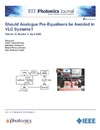Please use this identifier to cite or link to this item:
https://accedacris.ulpgc.es/jspui/handle/10553/71249
| DC Field | Value | Language |
|---|---|---|
| dc.contributor.author | Li, Xicong | en_US |
| dc.contributor.author | Ghassemlooy, Zabih | en_US |
| dc.contributor.author | Zvanovec, Stanislav | en_US |
| dc.contributor.author | Perez-Jimenez, Rafael | en_US |
| dc.contributor.author | Haigh, Paul Anthony | en_US |
| dc.date.accessioned | 2020-04-11T05:12:51Z | - |
| dc.date.available | 2020-04-11T05:12:51Z | - |
| dc.date.issued | 2020 | en_US |
| dc.identifier.issn | 1943-0655 | en_US |
| dc.identifier.other | Scopus | - |
| dc.identifier.uri | https://accedacris.ulpgc.es/handle/10553/71249 | - |
| dc.description.abstract | Visible light communication (VLC) systems are highly constrained by the limited 3-dB bandwidth of light-emitting diodes (LEDs). Analogue pre-equalisers have been proposed to extend the LED's bandwidth at the cost of reduced signal-to-noise ratio (SNR). Compared with the pre-equaliser, the multi-carrier modulation with bit-loading can efficiently use the spectrum beyond the LED's raw 3-dB bandwidth without incuring SNR penalties by employing multiple narrow quasi-flat sub-bands to eliminate the need for equalisation. In this work we show by means of theoretical and experimental investigation that VLC with multi-band carrierless amplitude and phase modulation with bit-loading can outperform VLC with analogue pre-equalisers. | en_US |
| dc.language | eng | en_US |
| dc.relation.ispartof | IEEE Photonics Journal | en_US |
| dc.source | IEEE Photonics Journal [ISSN 1943-0655], v. 12 (2), p. 1-14 | en_US |
| dc.subject | 3325 Tecnología de las telecomunicaciones | en_US |
| dc.subject.other | Cap. | en_US |
| dc.subject.other | Channel Capacity | en_US |
| dc.subject.other | Equaliser | en_US |
| dc.subject.other | Visible Light Communications (Vlc) | en_US |
| dc.title | Should analogue pre-equalisers be avoided in VLC systems? | en_US |
| dc.type | info:eu-repo/semantics/Article | en_US |
| dc.type | Article | en_US |
| dc.identifier.doi | 10.1109/JPHOT.2020.2966875 | en_US |
| dc.identifier.scopus | 85082659324 | - |
| dc.contributor.authorscopusid | 57211342846 | - |
| dc.contributor.authorscopusid | 7004547192 | - |
| dc.contributor.authorscopusid | 8346275300 | - |
| dc.contributor.authorscopusid | 56044417600 | - |
| dc.contributor.authorscopusid | 55103012600 | - |
| dc.identifier.issue | 2 | - |
| dc.relation.volume | 12 | en_US |
| dc.investigacion | Ingeniería y Arquitectura | en_US |
| dc.type2 | Artículo | en_US |
| dc.utils.revision | Sí | en_US |
| dc.identifier.ulpgc | Sí | es |
| dc.description.sjr | 0,725 | |
| dc.description.jcr | 2,443 | |
| dc.description.sjrq | Q1 | |
| dc.description.jcrq | Q2 | |
| dc.description.scie | SCIE | |
| item.fulltext | Con texto completo | - |
| item.grantfulltext | open | - |
| crisitem.author.dept | GIR IDeTIC: División de Fotónica y Comunicaciones | - |
| crisitem.author.dept | IU para el Desarrollo Tecnológico y la Innovación | - |
| crisitem.author.dept | Departamento de Señales y Comunicaciones | - |
| crisitem.author.orcid | 0000-0002-8849-592X | - |
| crisitem.author.parentorg | IU para el Desarrollo Tecnológico y la Innovación | - |
| crisitem.author.fullName | Pérez Jiménez, Rafael | - |
| Appears in Collections: | Artículos | |
SCOPUSTM
Citations
15
checked on Jun 8, 2025
WEB OF SCIENCETM
Citations
12
checked on Jun 8, 2025
Page view(s)
139
checked on May 31, 2025
Download(s)
189
checked on May 31, 2025
Google ScholarTM
Check
Altmetric
Share
Export metadata
Items in accedaCRIS are protected by copyright, with all rights reserved, unless otherwise indicated.
